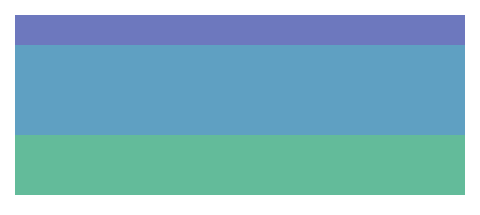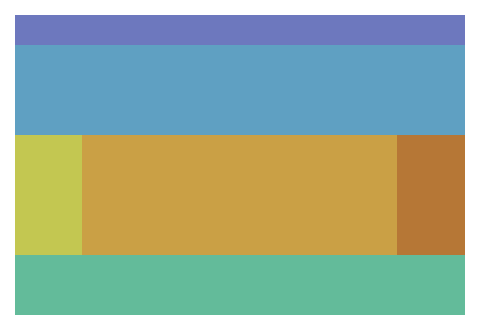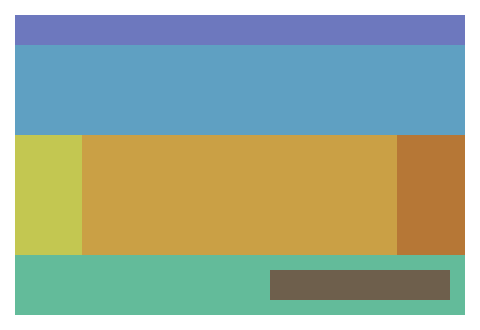Layouter class new in Git master
#include <Magnum/YogaIntegration/Layouter.h>
Yoga layouter.
A layouter implementation for the Ui library using Yoga Layout, which exposes a subset of CSS Flexbox.
Setting up a layouter instance
The layouter doesn't have any shared state or configuration, so it's just about constructing it from a fresh Ui::
YogaIntegration::Layouter& layouter = ui.setLayouterInstance( Containers::pointer<YogaIntegration::Layouter>(ui.createLayouter()));
Adding layouts to nodes
A layout is added to a particular node by calling add(). You can save the returned Ui::
Ui::NodeHandle root = ui.createNode({}, {}); Ui::NodeHandle header = ui.createNode(root, {}, {150, 10}); Ui::NodeHandle top = ui.createNode(root, {}, {150, 30}); Ui::NodeHandle bottom = ui.createNode(root, {}, {150, 20}); layouter.add(root); layouter.add(header); layouter.add(top); Ui::LayoutHandle bottomLayout = layouter.add(bottom);
Yoga by default lays out the nodes in a column and in the order add() is called. The layouts inherit node sizes, if specified, so in the above snippet the children all have a width of 150, and heights of 10, 30 and 20 respectively. The root node has no size specified and thus Yoga implicitly sizes it to fit all children. When visualizing node placement, for example with Ui::root being underneath the three children:

The add() function optionally accepts a layout before which to insert given child. To switch the layout direction for children of a particular node, use setFlexDirection(). The following snippet inserts a row above the bottom node, with three nested nodes next to each other:
Ui::NodeHandle middle = ui.createNode(root, {}, {0, 40}); Ui::NodeHandle left = ui.createNode(middle, {}, {15, 0}); Ui::NodeHandle center = ui.createNode(middle, {}, {70, 0}); Ui::NodeHandle right = ui.createNode(middle, {}, {15, 0}); /* Insert the middle node before the bottom one */ Ui::LayoutHandle middleLayout = layouter.add(middle, bottomLayout); layouter.setFlexDirection(middleLayout, YogaIntegration::FlexDirection::Row); layouter.add(left, YogaIntegration::Flag::PercentageNodeSize); layouter.add(center, YogaIntegration::Flag::PercentageNodeSize); layouter.add(right, YogaIntegration::Flag::PercentageNodeSize);
In the above Flag::middle, i.e. 40 units:

When adding layouts, restrictions coming from Ui::
Absolute positioning
Node offsets, if specified, by default shift the node relatively to its layout position. Calling setNodeOffsetType() allows you to change the offset to absolute, excluding given node from layout calculations and positioning it exactly as specified. Together with Flag::footer is placed 15 units from the bottom right corner of the bottom node:
Ui::NodeHandle footer = ui.createNode(bottom, {5, 5}, {60, 10}); Ui::LayoutHandle footerLayout = layouter.add(footer, YogaIntegration::Flag::NodeOffsetFromRightBottom); layouter.setNodeOffsetType(footerLayout, YogaIntegration::NodeOffsetType::Absolute);

Offsets, including absolute offsets, can be interpreted as percentages as well by enabling Flag::
Direct access to Yoga functionality
Right now, the Layouter exposes only a subset of Yoga functionality. It's however possible to call Yoga APIs directly on the Yoga node references returned by yogaNode(). Note that, however, you need to call setNeedsUpdate() afterwards to make the layouter aware of the changes and update the layout appropriately:
#include <yoga/Yoga.h> … Ui::LayoutHandle layout = layouter.add(…); YGNodeStyleSetFlexWrap(layouter.yogaNode(layout), YGWrapWrapReverse); layouter.setNeedsUpdate();
In case the implicit behavior of inheriting node offset and size is conflicting with direct Yoga API use, you might want to enable Flag::
Global Yoga configuration
All created layouts share the same Yoga configuration, which is exposed through yogaConfig(). Compared to Yoga defaults, snapping to a pixel grid is disabled to avoid stutter when animating node offsets and sizes. Similarly as with direct Yoga node access shown above, you can access and update the configuration yourself, but again you need to call setNeedsUpdate() afterwards to make the layouter aware of the changes. For example, the following snippet enables pixel grid snapping back:
YGConfigSetPointScaleFactor(layouter.yogaConfig(), 1.0f); layouter.setNeedsUpdate();
Debug layer integration
When using DebugLayer node inspect and Ui::
Node {0x8, 0x2} Offset: {15, 5}, size: {75, 0} Layout {0x3, 0x3} from layouter {0x1, 0x2} Yoga Flags: NodeOffsetFromRight|PercentageNodeSizeX Flex direction: Row Node offset type: Absolute
Base classes
- class Magnum::Ui::AbstractLayouter new in Git master
- Base for layouters.
Public types
- class DebugIntegration
- Debug layer integration.
Constructors, destructors, conversion operators
Public functions
- auto operator=(const Layouter&) -> Layouter& deleted
- Copying is not allowed.
- auto operator=(Layouter&&) -> Layouter& noexcept
- Move assignment.
- auto yogaConfig() -> YGConfigRef
- Yoga configuration used for all layout nodes.
- auto yogaConfig() const -> YGConfigConstRef
-
auto add(Ui::
NodeHandle node, Ui:: LayoutHandle before = Ui:: LayoutHandle:: Null, Flags flags = {}) -> Ui:: LayoutHandle - Add a layout assigned to given node.
-
auto add(Ui::
NodeHandle node, Flags flags) -> Ui:: LayoutHandle -
auto add(Ui::
NodeHandle node, Ui:: LayouterDataHandle before, Flags flags = {}) -> Ui:: LayoutHandle - Add a layout assigned to given node and before given layout assuming the layout belongs to this layouter.
-
void remove(Ui::
LayoutHandle handle) - Remove a node from this layouter.
-
void remove(Ui::
LayouterDataHandle handle) - Remove a node from this layouter assuming it belongs to it.
-
auto yogaNode(Ui::
LayoutHandle handle) -> YGNodeRef - Yoga node associated with given layout.
-
auto yogaNode(Ui::
LayoutHandle handle) const -> YGNodeConstRef -
auto yogaNode(Ui::
LayouterDataHandle handle) -> YGNodeRef - Yoga node associated with given layout assuming it belongs to this layouter.
-
auto yogaNode(Ui::
LayouterDataHandle handle) const -> YGNodeConstRef -
auto flags(Ui::
LayoutHandle handle) const -> Flags - Layout flags.
-
auto flags(Ui::
LayouterDataHandle handle) const -> Flags - Layout flags assuming it belongs to this layouter.
-
auto flexDirection(Ui::
LayoutHandle handle) const -> FlexDirection - Layout flex direction.
-
auto flexDirection(Ui::
LayouterDataHandle handle) const -> FlexDirection - Layout flex direction assuming it belongs to this layouter.
-
void setFlexDirection(Ui::
LayoutHandle handle, FlexDirection direction) - Set layout flex direction.
-
void setFlexDirection(Ui::
LayouterDataHandle handle, FlexDirection direction) - Set layout flex direction assuming it belongs to this layouter.
-
auto nodeOffsetType(Ui::
LayoutHandle handle) const -> NodeOffsetType - Layout node offset type.
-
auto nodeOffsetType(Ui::
LayouterDataHandle handle) const -> NodeOffsetType - Layout node offset type assuming it belongs to this layouter.
-
void setNodeOffsetType(Ui::
LayoutHandle handle, NodeOffsetType type) - Set layout node offset type.
-
void setNodeOffsetType(Ui::
LayouterDataHandle handle, NodeOffsetType type) - Set layout node offset type assuming it belongs to this layouter.
Function documentation
Magnum::
Constructor.
| Parameters | |
|---|---|
| handle | Layouter handle returned from Ui:: |
YGConfigRef Magnum::
Yoga configuration used for all layout nodes.
YGConfigConstRef Magnum::
This is an overloaded member function, provided for convenience. It differs from the above function only in what argument(s) it accepts.
Ui::
Add a layout assigned to given node.
| Parameters | |
|---|---|
| node | Node to assign the layout to |
| before | A layout to order before or Ui:: |
| flags | Flags |
| Returns | New layout handle |
The node is expected to not have a layout assigned from this layouter yet. If before is not null, it's expected to be valid, belong to the same layouter and have the same non-null parent layout as node.
If before is Ui::
Ui::
This is an overloaded member function, provided for convenience. It differs from the above function only in what argument(s) it accepts.
Ui::
Add a layout assigned to given node and before given layout assuming the layout belongs to this layouter.
Like add(Ui::before indeed belongs to this layouter. See its documentation for more information.
void Magnum::
Remove a node from this layouter.
Expects that handle is valid and has no child layouts from the same layouter. To remove a layout that has children, either remove the child layouts first or remove the whole node along with its children using Ui::
void Magnum::
Remove a node from this layouter assuming it belongs to it.
Like remove(Ui::handle indeed belongs to this layouter. See its documentation for more information.
YGNodeRef Magnum::
Yoga node associated with given layout.
Expects that handle is valid.
YGNodeConstRef Magnum::
This is an overloaded member function, provided for convenience. It differs from the above function only in what argument(s) it accepts.
YGNodeRef Magnum::
Yoga node associated with given layout assuming it belongs to this layouter.
Like yogaNode(Ui::handle indeed belongs to this layouter. See its documentation for more information.
YGNodeConstRef Magnum::
This is an overloaded member function, provided for convenience. It differs from the above function only in what argument(s) it accepts.
Flags Magnum::
Layout flags.
Expects that handle is valid. Note that, to reduce implementation complexity, the flags can be only specified in add() and cannot be modified afterwards.
Flags Magnum::
Layout flags assuming it belongs to this layouter.
Like flags(Ui::handle indeed belongs to this layouter. See its documentation for more information.
FlexDirection Magnum::
Layout flex direction.
Expects that handle is valid.
FlexDirection Magnum::
Layout flex direction assuming it belongs to this layouter.
Like flexDirection(Ui::handle indeed belongs to this layouter. See its documentation for more information.
void Magnum::
Set layout flex direction.
Corresponds to the CSS flex-direction property, see the linked documentation for detailed explanation. Expects that handle is valid. Default is FlexDirection::flex-direction: column; in CSS.
Calling this function causes Ui::
void Magnum::
Set layout flex direction assuming it belongs to this layouter.
Like setFlexDirection(Ui::handle indeed belongs to this layouter. See its documentation for more information.
NodeOffsetType Magnum::
Layout node offset type.
Expects that handle is valid.
NodeOffsetType Magnum::
Layout node offset type assuming it belongs to this layouter.
Like nodeOffsetType(Ui::handle indeed belongs to this layouter. See its documentation for more information.
void Magnum::
Set layout node offset type.
Corresponds to the CSS position property, see the linked documentation for detailed explanation, Expects that handle is valid. Default is NodeOffsetType::position: relative; in CSS.
Calling this function causes Ui::
void Magnum::
Set layout node offset type assuming it belongs to this layouter.
Like setNodeOffsetType(Ui::handle indeed belongs to this layouter. See its documentation for more information.